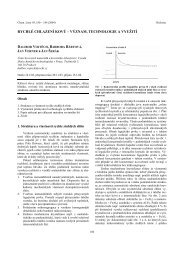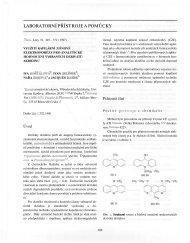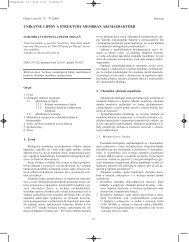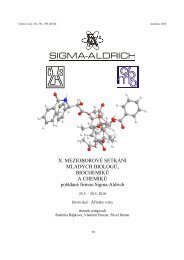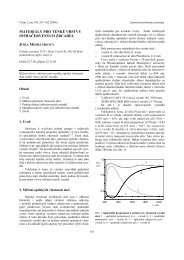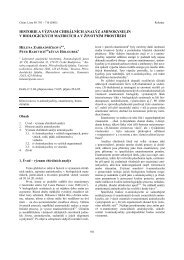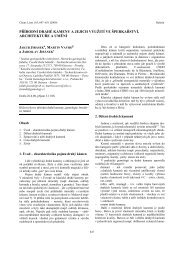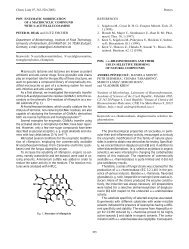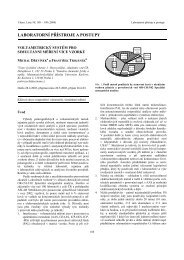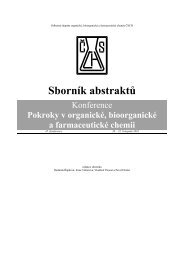iv. mezioborové setkênè mladðch biologů ... - Chemické listy
iv. mezioborové setkênè mladðch biologů ... - Chemické listy
iv. mezioborové setkênè mladðch biologů ... - Chemické listy
Create successful ePaper yourself
Turn your PDF publications into a flip-book with our unique Google optimized e-Paper software.
Chem. Listy 98, 271 – 314 (2004) IV. Amerika 2004.<br />
currently known. Only L. monocytogenes has been recognized<br />
as an important foodborne pathogen causing infections in both<br />
man and animal. L. <strong>iv</strong>anovii is primarily pathogenic for cattle<br />
and sheep. The other Listeria spp. are considered to be<br />
avirulent, although L. innocua may occasionally cause disease<br />
in ruminants and L. seeligeri has been implicated in at least<br />
one case of human listeriosis. Listeria spp. can be isolated<br />
from a d<strong>iv</strong>ersity of environmental sources, including soil,<br />
water, effluents, a large variety of foods, and the feces of<br />
humans and animals.<br />
The aim of our work was to develop rapid and simple<br />
method for general detection of genus Listeria and specific<br />
determination of Listeria monocytogenes. Two polyclonal<br />
antisera had previously been developed. With these antisera<br />
ELISAs had been set up, one specific for Listeria spp., and the<br />
other specific for L. monocytogenes. In the present study these<br />
antibodies were used to develop easy-to-use Lateral Flow<br />
ImmunoAssays that only require the addition of culture<br />
supernatant into the sampling window.<br />
This work was supported by the Grant Agency of the Czech<br />
Republic, No. 525/03/0350.<br />
PA-IIL LEKTIN Z HUMÁNNÍHO PATOGENU<br />
Pseudomonas aeuruginosa A JEHO INTERAKCE S<br />
OLIGOSACHARIDY<br />
MARTINA BUDOVÁ a , CHARLES SABIN b , EDWARD P.<br />
MITCHELL c , NECHAMA GILBOA-GARBER d , ANNE<br />
IMBERTY b , and MICHAELA WIMMEROVÁ a,e<br />
a National Centre for Biomolecular Research and e Department<br />
of Biochemistry, Masaryk Un<strong>iv</strong>ersity, Kotlarska 2, 611 37<br />
Brno, Czech Republic, b CERMAV-CNRS, 601 rue de la<br />
Chimie, BP 53, 38041 Grenoble, France, c ESRF, Experiments<br />
D<strong>iv</strong>ision, BP 220, 38043 Grenoble, France, d Bar Ilan<br />
Un<strong>iv</strong>ersity, Faculty of Life Sciences, Ramat Gan 52900, Israel<br />
budova@chemi.muni.cz<br />
Pseudomonas aeruginosa je gram-negat<strong>iv</strong>ní potenciálně<br />
patogenní bakterie, která je schopna infikovat téměř každou<br />
lidskou tkáň a např. u pacientů s cystickou fibrosou způsobuje<br />
těžkou infekci plic. Nejčastější příčinou úmrtí pacientů s<br />
cystickou fibrosou jsou právě důsledky kolonizace plic touto<br />
bakterií. P. aeruginosa produkuje významné množství lektinů<br />
vázajících D-galaktosu a L-fukosu, PA IL (LecA) a PA IIL<br />
(LecB), které jsou pravděpodobně odpovědné za primární<br />
rozpoznání hostitele a následnou adhezi bakterie a jsou úzce<br />
spjaty s virulencí tohoto patogenu 1 .<br />
Na rozdíl od většiny lektinů, jež vykazují relat<strong>iv</strong>ně<br />
nízkou afinitu k monomerním cukerným ligandům, interakce<br />
PA-IIL s fukosou je charakterizována afinitní konstantou v<br />
mikromolární oblasti. Strukturní analýza prokázala, že PA-IIL<br />
lektin je tetramer složený ze čtyř identických podjednotek,<br />
každá z nich obsahuje vazebné místo se dvěma Ca 2+ ionty,<br />
které se přímo podílí na vazbě sacharidu a jsou pravděpodobně<br />
příčinou neobvykle silné interakce mezi proteinem a cukerným<br />
zbytkem 2 . Význam četných aminokyselin především kyselého<br />
charakteru zapojených do interakce se sacharidy a jejich podíl<br />
na vazbě nám pomáhá odhalit jejich cílená mutagenese a<br />
následná charakterizace mutantů. Zvláštností vazebného místa<br />
je i zapojení C-terminálního glycinu sousedního monomeru do<br />
přímé interakce se sacharidem.<br />
Krystaly PA-IIL lektinu se daří připravit v dostatečné<br />
velikosti, což nám otevřelo novou možnost řešení kvartérní<br />
struktury proteinu na atomární úrovni neutronovou difrakcí. V<br />
současné době probíhá příprava plně deuterovaného proteinu,<br />
jež by měl umožnit pohled především na vodíkové atomy,<br />
které jsou přímo zapojeny do interakce, ať už kyselých<br />
aminokyselin ve vazebném místě či hydroxylových skupin<br />
sacharidu.<br />
LITERATURA<br />
1. Imberty A., Wimmerová M., Mitchell E. P., Gilboa-<br />
Garber N.: Microb. Infect, 6, 222 (2004).<br />
2. Mitchell E., Houles C., Sudakevitz D., Wimmerová M.,<br />
Gautier C., Pérez S., Wu A. M., Gilboa-Garber N.,<br />
Imberty A.: Nature Struct. Biol. 9, 918 (2002).<br />
ANTENNA RING AROUND TRIMERIC<br />
PHOTOSYSTEM I IN A PHOTOSYNTHETIC<br />
PROKARYOTE Prochlorothrix hollandica<br />
L. BUMBA a,b , M. HUŠÁK b , and F. VÁCHA b,c<br />
a Faculty of Biological Sciences; b Institute of Plant Molecular<br />
Biology, Czech Academy of Sciences; c Institute of Physical<br />
Biology, Un<strong>iv</strong>ersity of South Bohemia, Branišovská 31, 370 05<br />
České Budějovice<br />
bumba@umbr.cas.cz<br />
Three known species of prochlorophytes (Prochloron<br />
didemni, Prochlorothrix hollandica and Prochlorococcus<br />
marinus) are an unusual group of prokaryotes which perform<br />
oxygenic photosynthesis 1 . They are apparently related to<br />
cyanobacteria but they lack water-soluble phycobilisomes<br />
while they synthesize chlorophyll (chl) b and to form an<br />
intrinsic chla/b light-harvesting antenna. The chla/b-binding<br />
proteins (encoded by pcb genes) are not closely related to the<br />
lhc genes encoding a superfamily of the light-harvesting<br />
antenna proteins of green plastids, but instead are similar to the<br />
iron-stress induced isiA gene of cyanobacteria and to CP43, a<br />
chla-antenna protein of photosystem II (cf. 2 ). In P. holandica<br />
three Pcb antenna proteins (pcbA-C gene products) have been<br />
detected 3 . Here we show how the antenna proteins structurally<br />
interact with the photosystem I (PSI) reaction center in P.<br />
holandica. The isolated thylakoid membranes of P. hollandica<br />
were solubilized by mild detergent dodecyl-β-D-maltoside and<br />
subjected to a sucrose density gradient centrifugation. On the<br />
basis of protein composition and spectroscopic data the lowest<br />
green fraction of sucrose gradient contained polypeptides of<br />
the PSI reaction center complex associated with the Pcb<br />
proteins. In order to reveal how the PSI complex interact with<br />
the Pcb proteins the fraction was negat<strong>iv</strong>ely stained with<br />
uranyl acetate, subjected to electron microscopy and obtained<br />
images processed with SPIDER image analysis package 4 .<br />
Single particle analysis showed a Pcb-PSI supercomplex to be<br />
a more circular particle with a diameter of about 32 nm. This<br />
275



